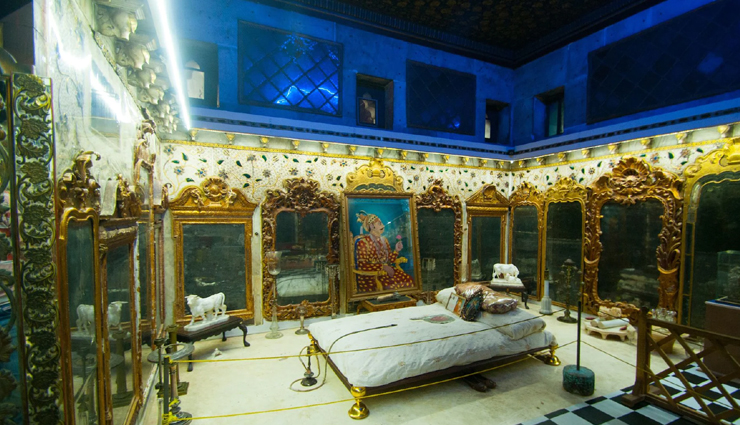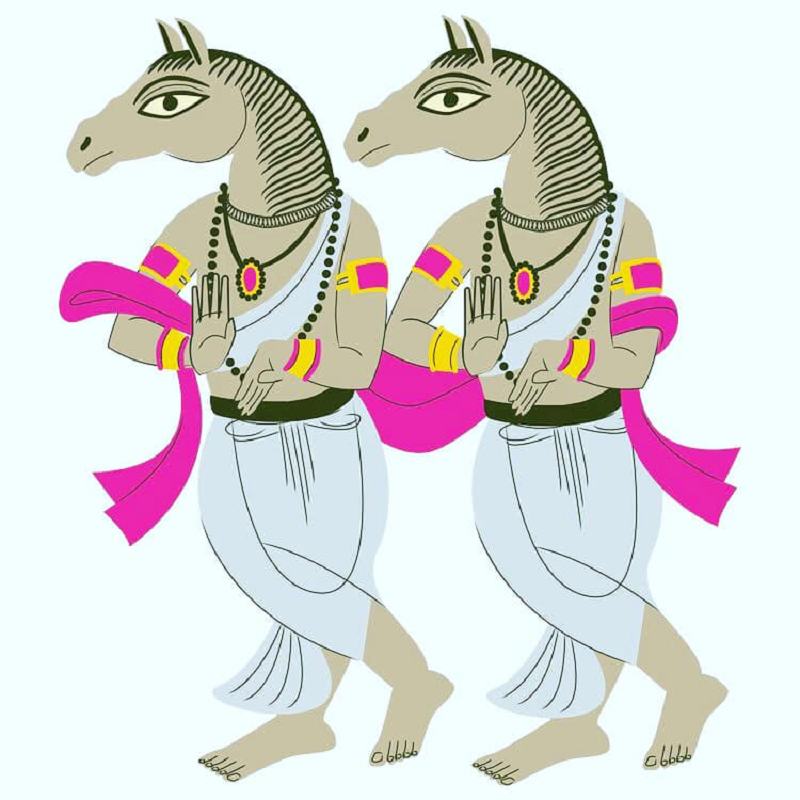Narayan Sarovar is a major pilgrimage site for Hindus in Lakhpat taluka of Kutch district of Gujarat. This lake is one of the five holy lakes of Hindus. Here the Sindhu River meets the sea. Narayan Sarovar is related to Lord Vishnu. There is an ancient and grand temple of Lord Adinarayan on the banks of Narayan Sarovar. Along with this, the temples of Trikamraiji, Laxminarayanji, Govardhannathji, Dwarkanathji, Ranchhodrayaji, and Laxmiji are also built here. It is believed that these temples were built by the wife of Maharao Desalji. The famous Koteshwar Shiva temple is four kilometers away from here.

The holy Narayan Sarovar has also been described in Shrimad Bhagwat. According to Shrimad Bhagwat, Dasapachetas, son of King Barhis, performed penance at this place to get a son. After listening to Rudragaan from Dasapachetas Lord Rudra, he kept on chanting Rudra for about 10 thousand years. The Lord was pleased with his penance and he got a son, who was named Daksh Prajapati.
One of the five important lakes, Narayan Sarovar, is related to Lord Vishnu. The names of the other lakes are- Maan Sarovar, Bindu Sarovar, Pampa Sarovar, and Pushkar Sarovar.
- Where is Narayan Sarovar: Narayan Sarovar is located in Lakhpat tehsil of Kutch district of Gujarat. To reach Narayan Sarovar, first reach Bhuj. You can come to Bhuj from Delhi, Mumbai, and Ahmedabad by rail.
- Two ancient temples: There is an ancient and grand temple of Lord Adinarayan on the banks of the holy Narayan Sarovar. The ancient Koteshwar temple is at a distance of 4 km from here.
- The lake is at the confluence of Sindhu: 'Narayan Sarovar' means- 'Vishnu's lake'. Here the Sindhu River meets the sea. The holy Narayan Sarovar is on the banks of this confluence. This holy Narayan Sarovar is mentioned in Shrimad Bhagwat.
- Visit of famous people: There are references to many ancient sages visiting this holy lake. Adi Shankaracharya also came here. Chinese traveler Hiuen Tsang has also mentioned this lake in his book 'Siyuki'.
- Grand fair: A grand fair of 3 days is organized in Narayan Sarovar from Kartik Purnima. Sadhus, monks, and other devotees of all sects of North India participate in it. Devotees also perform the shraddha of their ancestors in Narayan Sarovar.
Mythological belief
The local people believe about Narayan Sarovar that once there was a terrible drought in the mythological era. To get out of this crisis, the sages did a lot of penance of Lord Vishnu. Pleased with the penance of the sages, Lord Vishnu appeared in the form of Narayan and touched the ground with his toe. With the touch of Lord Vishnu, a lake was formed there, which is known as Narayan Sarovar.
People have deep faith in Narayan Sarovar. Every year lakhs of devotees come to Narayan Sarovar to take a dip. It is believed that Lord Vishnu took a bath here. Therefore, taking a dip in this lake leads to salvation. Every year a three-day fair is also held here on the occasion of Kartik Purnima. Sadhus, saints, and devotees of all sects of North India come to this fair. Devotees also perform the shraddha of their ancestors in Narayan Sarovar. It is believed that in ancient times many saints and mahatmas had come to this place. Adi Guru Shankaracharya also came to this place.
A huge lake on the western end of India, Narayan Sarovar has great spiritual significance. Along with Mansarovar in Tibet, Pampa in Karnataka, Bhubaneswar in Odisha, and Pushkar in Rajasthan, it is one of the 5 holy lakes of Hinduism and is considered a prestigious place for holy baths. An adjoining temple built by Maharao Desalji's wife houses temples of Shri Trikamraiji, Laxminarayan, Govardhannathji, Dwarkanath, Adinarayan, Ranchhodrayji and Laxmiji. A short drive from here, the Koteshwar Mahadev Temple is an imposing sandstone structure overlooking a marshy sea. Temples dedicated to Shiva and Ganesha are the main attractions here.
Brief History—Narayan Sarovar has its origins in the Puranas. It is said that there was a drought in the region, and Lord Vishnu appeared in response to fervent prayers by sages. When he touched the land with his toe, a lake immediately formed, relieving the locals of their miseries. It is one of the sacred lakes of Hinduism, along with Manasarovar in Tibet, Pampa in Karnataka, Bhubaneshwar in Odisha, and Pushkar in Rajasthan.
Lakhpat Fort
Just 33km north of Narayan Sarovar lies the town of Lakhpat, with a walled fort as its main attraction. The town was an important coastal trade center in the 18th century. At the mouth of Kori Creek, the walls of the large fort still bear testimony to a short but glorious past. One can climb the ramparts of the fort, the only remaining structure of the fort, and look out at the calm sea. The place is especially stunning at sunset. There is also a 16th-century gurdwara within the fort walls. Guru Nanak is believed to have stayed here twice during his second (1506-1513) and fourth (1519-1521) missionary journeys, called Udasi. The gurdwara is a pleasant spot for travelers. Gentle bhajans play continuously in the background, as travelers visit the ancient Sikh place of worship to see relics such as wooden shoes, palanquins (palanquins), manuscripts, and icons of two important chiefs of the Udasi sect.
Brief History—The ruins of Lakhpat Fort are a reminder that this place was a thriving trade hub. The more than 200-year-old ramparts still keep the Arabian Ocean at bay. The fort is said to be named after Rao Lakha, who ruled Sindh in the mid-thirteenth century. It was the 1800s when this small town saw the most political changes, with the town changing hands from Fateh Muhammad, who extended the walls, to Mohim Miyam, the commander of the fort. It fell into ruins through the century, as trade dwindled, and the people of the town moved to better pastures.
Gurudwara Lakhpat Sahib
This is a historic Gurudwara associated with Guru Nanak. Gurdwara Lakhpat Sahib is also located in the old fort of Lakhpat. In front of the Guru Darbar is a large wooden palanquin in which two pairs of historic wooden Khadau are kept for the Sangat to see. These two pairs of wooden Khadau are said to belong to Guru Nanak Dev Ji and his son Baba Sri Chand Ji. On the left side of the Guru Darbar, Guru Granth Sahib is seated in a beautiful palanquin. Sukhmani Paath takes place here on Sundays, for which Sikh Sangat from Kutch region comes to Gurudwara Sahib. The minds of the people present there become happy after listening to the bani of Sukhmani. There is also a langar hall here, where food is arranged for the visitors. Here every person is served a plate with Prasad, dal, rice, water, and pickles along with a pinch of salt because the amount of salt in the air and water here is quite high. If someone feels less salt, then he can add a pinch of salt to the dal.

History of Gurudwara Lakhpat Sahib
Gurudwara Lakhpat Sahib is located near the Pakistan border, 135 km from Bhuj in the Kutch district of Gujarat. This historical place has the touch of Guru Nanak Dev Ji and Baba Shri Chand Ji. Guru Nanak Dev Ji came here twice, the first time was when he went to Mecca to travel in the west. Lakhpat was a very big port on the coast of Sindh, boats were also available. Guru Ji also went to Mecca on Bedi Pakad through this route. At that time Lakhpat was part of Sindh province, now Kutch of Gujarat, the Indus River flows far west. Karachi, the largest city of Pakistan is just 250 km from Lakhpat. Guru came here for the second time when he returned to Punjab due to the sadness of the south. The historic wooden slippers of Guru Ji and Baba Shri Chand Ji are also kept in Lakhpat Gurdwara Sahib. The Bhuj earthquake in 2001 caused heavy damage to the building of Gurdwara Sahib but the building of Guru Ghar has been built in the same way. Similarly, Gurdwara Lakhpat Sahib was awarded the UNESCO Asia Pacific Award in 2004 for maintaining this historic building as the Guru Ghar has maintained its heritage even after the 2001 earthquake.
A grand fair is held at Narayan Sarovar.
A grand fair of 3 days is held here from Kartik Purnima, in which sadhus, sanyasis, and other devotees of all sects of Uttar Pradesh participate, devotees also perform Shradh for their ancestors in Narayan Sarovar. Devotees come here to calm their minds.
Aaina Mahal
This beautiful palace in Bhuj, built in 1752, lost its top floor in an earthquake, but the lower floor is open to visitors, with a magnificent scroll of 15.2 meters showing the Kutch state procession. The palace is one of three located in the walled complex of the old part of the city. The elaborate mirrored interior of the 18th century is a display of the charm of all things European - an inverted mirror of European orientalism - with blue and white Delphi-style tiles, a candelabra with Venetian-glass shades, and the Harding lithograph series The Rake's Progress. The top of the tower offers spectacular views of the Rani Mahal. The palace was built for Maharao Lakhpatji by Ram Singh Malam, a boatman from Dwarka, who visited the palace during his travels.
The rain had learnt European arts and crafts. The bedroom has a bed with solid gold legs (the king auctioned his bed annually). In the room of the Fuwara Mahal, fountains played around the ruler while he watched dancers or composed poems.
Brief History—Maharao Lakhpatji commissioned the project in 1750 to architect and designer Ram Singh Malam, who had lived in Europe for 18 years and mastered many European architectural skills. There is an interesting legend around Maharao Lakhpatji. It is said that he used his beds for only one year and then auctioned them off. The museum is a royal display of jewelry, weapons, and art of Kutch.
Koteshwar Mahadev Temple
After traveling the desert expanse in western Kutch, you find the Koteshwar Temple at a place where the vastness of the arid land meets the incomparable vastness of the sea. The sight of the sea after such a barren land will lift your spirits; Though the sea is even less hospitable to humans, it is a sobering thought. The last outpost of human creation on India's westernmost border, the point of the Koteshwar temple is the only point that breaks the horizon into the flat brown horizon to the east and the wide blue horizon to the west. Not populated by tourists like the temple at Dwaraka, Koteshwar is conducive to contemplating emptiness, to pondering humanity's place on earth (and ultimately, what isn't that about spiritual traditions?).
The story of Koteshwar begins with Ravana, who won a boon from Lord Shiva for an outstanding display of piety. This boon was the gift of a Shiva linga of great spiritual power, but Ravana in his arrogant haste accidentally dropped it and it fell to earth at Koteshwar. To punish Ravana for his carelessness, the linga turned into a thousand identical copies (some versions of the story say ten thousand, some a million; suffice it to say it was enough.) Unable to distinguish the original, Ravana grabbed one and walked away, leaving the original behind, around which the Koteshwar temple was built.
Visitors can see the temple, walk along the beach, and, on a clear night, even see the glow of light on the northwestern horizon from Karachi, Pakistan.
(PC: Lifeberrys)










